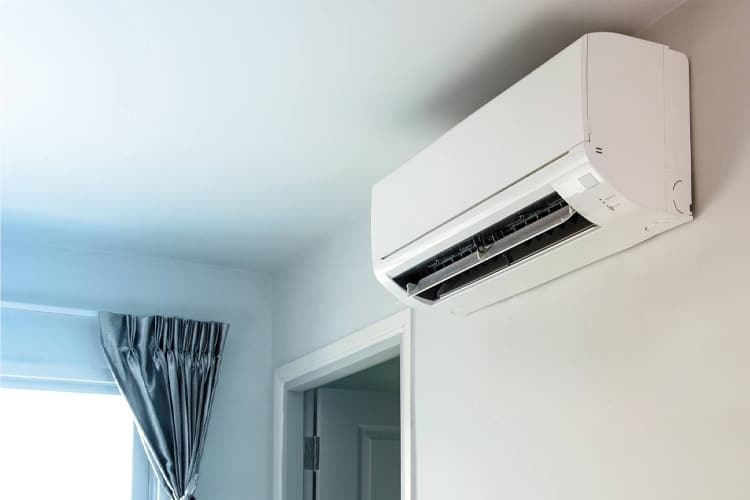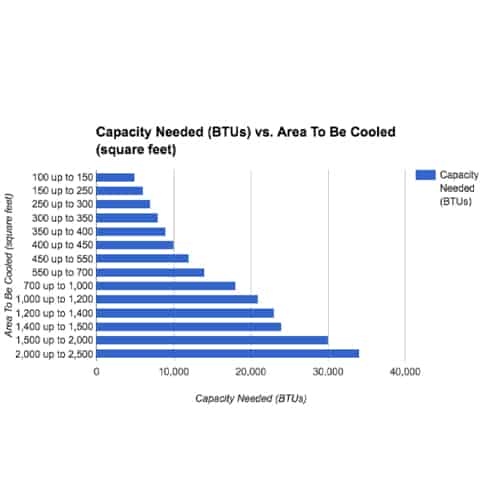What is a Mini-Split AC?
Nearly every home in the world requires some form of climate control, whether it be for heating or cooling. Central air conditioning and large heating furnaces are used in many applications, but they require expensive units and infrastructure.
For those who do not wish to invest in these systems, there is an exciting alternative in the form of mini-split systems. Mini split systems are small, ductless devices that offer combined heating and cooling functionality with very little need for alteration to your home.
The technology behind mini split systems has gone through an astonishing level of advancement in the last few years. The systems of today are nearly unrecognizable to their predecessors, even those that are just a few years old.

While a lot of people are just learning about ductless AC and heating systems, the mini-split systems of today are quickly becoming a common choice for those who wish to install HVAC systems. Even so, questions about the systems still abound due to their relatively new status. As such, we’ve tried to answer those questions, and a few you might not have thought to ask, in the article below.
A Mini-Split System is an AC and Furnace in One – and It’s Ductless
A simple way of answering that question is that they are an alternative technology to traditional centralized, and separate, heating and cooling systems. They are essentially an AC and furnace in one. They do share some similarities with traditional systems, including the need for an interior handling unit and an outdoor condenser.
In contrast to traditional air conditioners, mini-split systems do not require the installation or adaption of a duct system in the home. This is a big difference to traditional heating and cooling units where the presence, and quality, of ductwork is crucial to the effectiveness of the system. This simplicity is why more and more homeowners are choosing mini-split systems.
Adding to people’s confusion over what a mini-split system is the fact that they are known by a variety of other names and descriptive titles including: Ductless mini-splits, ductless heat pumps, and mini-split heating systems.
How Mini Mini-Split Systems Work
In order to understand how a mini-split system works it is crucial that you are familiar with three components in particular.
- Air handling units are installed on the wall or hanging from the ceiling in each climate control zone. If you have multiple floors or a lot of rooms, you may need more than one air handling unit. Some systems allow up to four air handling units on one condenser. The air handling unit is a fan that circulates the air throughout the zone, room, or floor.
- The compressor, otherwise known as the condenser, is installed on the exterior of your home, either on the ground or on the rooftop. A mini-split systems condenser is usually notable for its thin profile in comparison to the larger units used for traditional air conditioning systems.
- The last component you should be aware of is its refrigerant pipes. Thin copper tubing is used to connect the condenser to the air handling units throughout the property and carries the coolant that is responsible for both heating and cooling between the two. During the winter months the coolant absorbs heat from the outside and carries it inside to heat the home, in the summer the opposite process occurs, with the heat from the interior of the home being absorbed and carried outside.
The entire system operates using a principle called variable refrigerant flow. The system uses varied flow of the coolant to regulate the temperature inside. Because these systems are able to regulate the flow of the refrigerant, they’re able to maintain much more constant temperatures at a fraction of the cost to cool or heat a room using traditional central air conditioning systems.
Mini-Split Systems Cost Less to Operate
Mini-split systems are incredibly efficient, allowing them to use two to three times less energy than a comparative central heating system. This is good news for most property owners since less energy used means a cheaper utility bill.
One of the ways that you can save energy costs with mini-split systems is by using multiple air handlers to control different zones or rooms independently. This allows you to save money by not running the AC in areas you are not using. These air handlers are also better at maintaining temperature in the room, which also improves efficiency.
The most significant way that mini-split systems increase efficiency is their elimination of the need for ductwork. Ducts are usually not insulated, and the cool air has to travel through the ducts to the area needing to be cooled. The heat lost to the system of ducts throughout a house can be as significant as 30 percent or more. This is especially true for rooms that are not well insulated.
Are Mini Split Systems Always the Best Option?
A mini split system will be a good choice for homeowners whose properties:
- Have enough space that you would like to create a more exact set of heating and cooling zones throughout.
- Would benefit from a less intrusive alternative to a bulky window-mounted unit.
- Have no duct work previously installed.
- Would benefit from a significantly lower utility bill.
- Have sunrooms, FROGs, Garages, Bonus rooms, basements, sheds or man caves that would benefit from climate control.
- Have specific cooling needs within a single room of a commercial space such as an IT server room, storage closets that need to be climate controlled, etc.
There are a couple reasons that you may wish to pick a more centralized system for your property:
- The design of a mini-split system may not match the pre-existing aesthetics of your home. If your house already has ductwork in place central heating and cooling is more likely the better choice.
- You may find that the air blower of the mini-split system may generate too much noise. While the newer mini-split systems are vastly quieter than the older models and are usually unnoticeable, some particularly sensitive people may find the air blower of lower quality units too much to handle.
Choosing a Mini-Split System for Your Home
If you have chosen to install a mini-split system, there are a few important factors to consider before making a purchase and actually beginning to install the system:
- Are you looking for both heating and cooling or just a single functionality?
- How many air handling units will you be needing to achieve the effect you want?
- What capacity do you need your system to be capable of handling?
Determine Your HVAC Functionality Needs
Most mini-split systems currently on the market can provide both heating and cooling to where they are installed. Mini-split systems with a mono-functionality can also be found relatively easily, and are cheaper than counterparts that offer both.
Mini-split systems are able to work in temperatures as freezing as -15 degrees Fahrenheit and as scorching as 115 degrees. Indeed, in all but the most extreme places a mini-split system is very capable of functioning. Most places have a variation in seasonal temperatures that make both heating and cooling necessary, but you can get systems that are one or the other as well.
You Need an Air Handler for Each Necessary Room or Zone
One of the advantages to mini-split systems is that they can be used to create multiple climate-controlled zones. Each zone requires its own air handling unit connected to the condenser, which can be connected to up to four handlers. Some advanced systems may be able to handle as many as eight air handlers. This allows you to heat and cool individual rooms or areas only when in use.
The Size of Your Home Decides What Capacity You Need
Like any other central heating or cooling system, the capacity that mini-split systems are capable of is measured in British Thermal Units or BTU. A BTU is the amount of energy needed to heat a pound of water by single degree Fahrenheit.
The larger the BTU capacity of an HVAC system is directly related to how much space that system can heat or cool. Small cooling units might be rated to only five thousand BTU, or roughly enough power to cool 100 square feet, while larger units will have a capacity of over 34,000 BTU. The capacity of the mini-split system must therefore correspond to the amount of space it must heat or cool.
A higher capacity system may not be the most effective. If your HVAC system handles far more capacity than you need it will be an energy waster and may not be as effective. It can also strip the moisture from the air, creating an extra-dry environment that can lead to dry skin, dry eyes, and aggravated breathing conditions.

The best way to estimate what size system you need is to use the manual J load calculation method. This a common calculation used by HVAC specialists to determine how much power is needed for a system. The Manual J load calculation factors in different characteristics of a home such as square footage, building materials, geographic location, how much sunlight hits a particular part of the house, and even how much heat is being produced by other appliances. While there are free online calculators to run this calculation, we highly recommend having a professional HVAC service technician run these calculations to make sure that all the factors that can affect how large of a unit you need are taken into account.
Frequently Asked Questions
Can I purchase and install a mini-split system on my own?
Proper placement and installation is crucial when installing ductless systems. This is because an improperly placed air-handler can cause a defect known as ‘short-cycling’. If this occurs, energy will be utilized much less efficiently.
Due to their relatively new status, not all HVAC installers will work with mini-split systems. HVAC professionals must be trained in both the installation and sizing or design of mini-split systems. Hiring an unqualified professional or trying to install the system yourself will reduce its efficiency, if it works at all.
Are all mini-split systems the same?
Mini-split systems are very flexible and can be sized or designed to meet your home’s specifications and climate control needs. Few mini-split systems are exactly the same, but they are similar enough to be recognizable.
Are mini-split systems discrete?
Compared to window units, mini-split systems are extremely discrete. These systems can be just as discrete as central cooling, as long as your air handlers are recessed into the wall or ceiling.
Are mini-split systems expensive?
While not nearly as expensive as the installation of new duct work, mini-split systems are vastly more expensive than window mounted-units due both to the installation fees and the upfront cost.
Conclusion
A mini-split system is a fantastic alternative to a traditional centralized heating or cooling system, especially if there is no existing ductwork within the property to allow for centralized climate control systems to be installed. Not only are they cost-effective to install compared to new duct work, but a mini-split system can also climate control different areas within the house at an efficiency unheard of for centralized systems. This increase in efficiency is so significant that those who install mini-split systems often see the costs associated with climate controlling their properties drop by up to fifty percent.
If you are interested in installing a mini-split system in your home, contact us today so we can determine the best manufacturer and capacity for your home’s climate control needs. We can also design and install your mini-split system.
Expert Consultation – Only A Call Away!
Carolina Comfort, Inc. has been serving the neighborhoods of Columbia, South Carolina for over two decades. This means that when it comes to air conditioning systems, we really know our business.
From assessing your cooling requirements to bringing down costs associated with faulty air conditioning units, Carolina Comfort, Inc. can serve all your AC related needs.
The best part is that we pride on being available 24/7 for our customers.
After all, air conditioning systems can stop working any time, and so our technicians are always available to deal with any AC related emergencies – whether it is a weekend, holiday, or the middle of the night!
If you have any questions, need a consultation, or someone to repair your air conditioning unit – call us now!

5636 Bush River Rd.
Columbia, SC 29212
SC License – #M104545
NC License – #32356
Phone: (803) 794-5526

